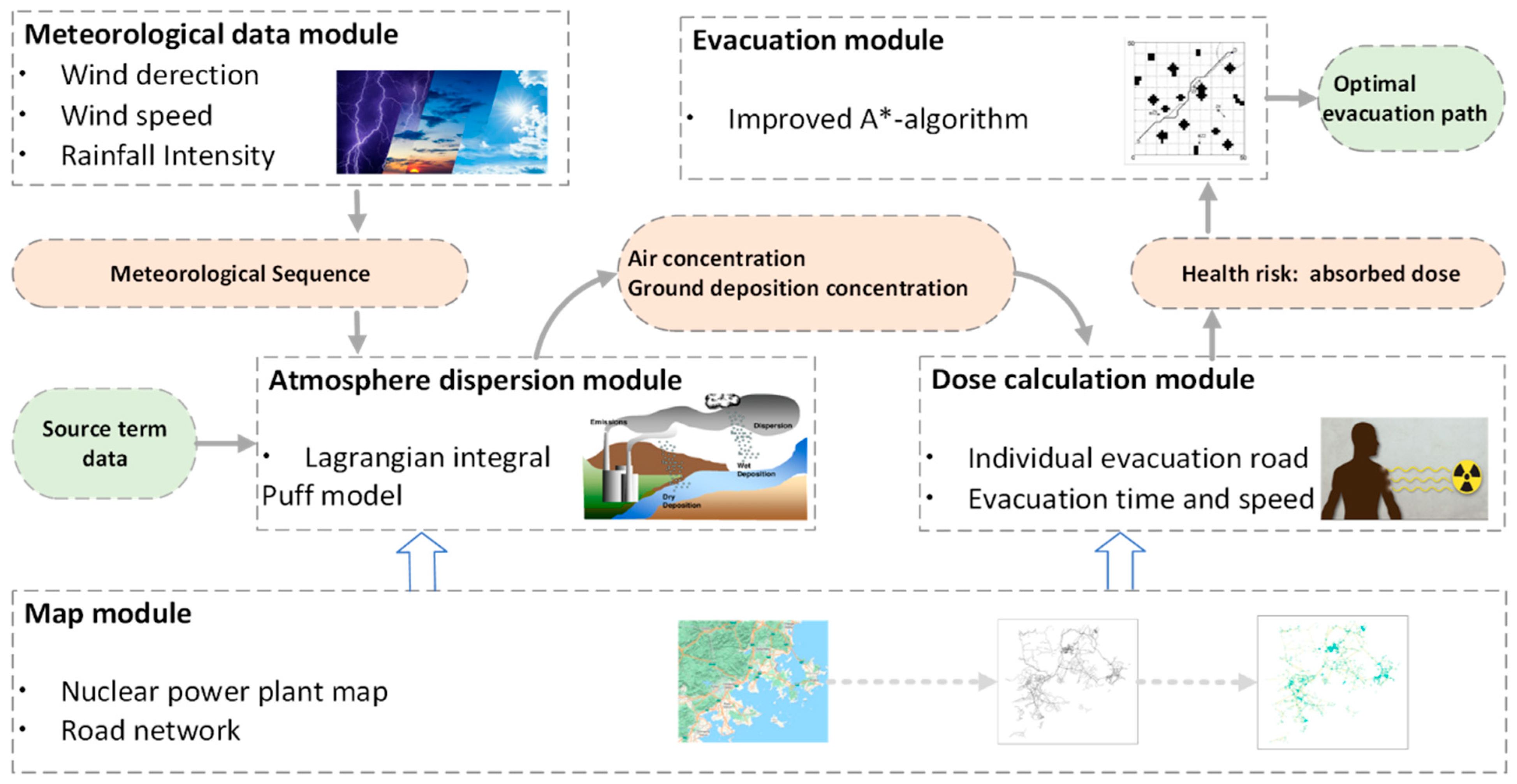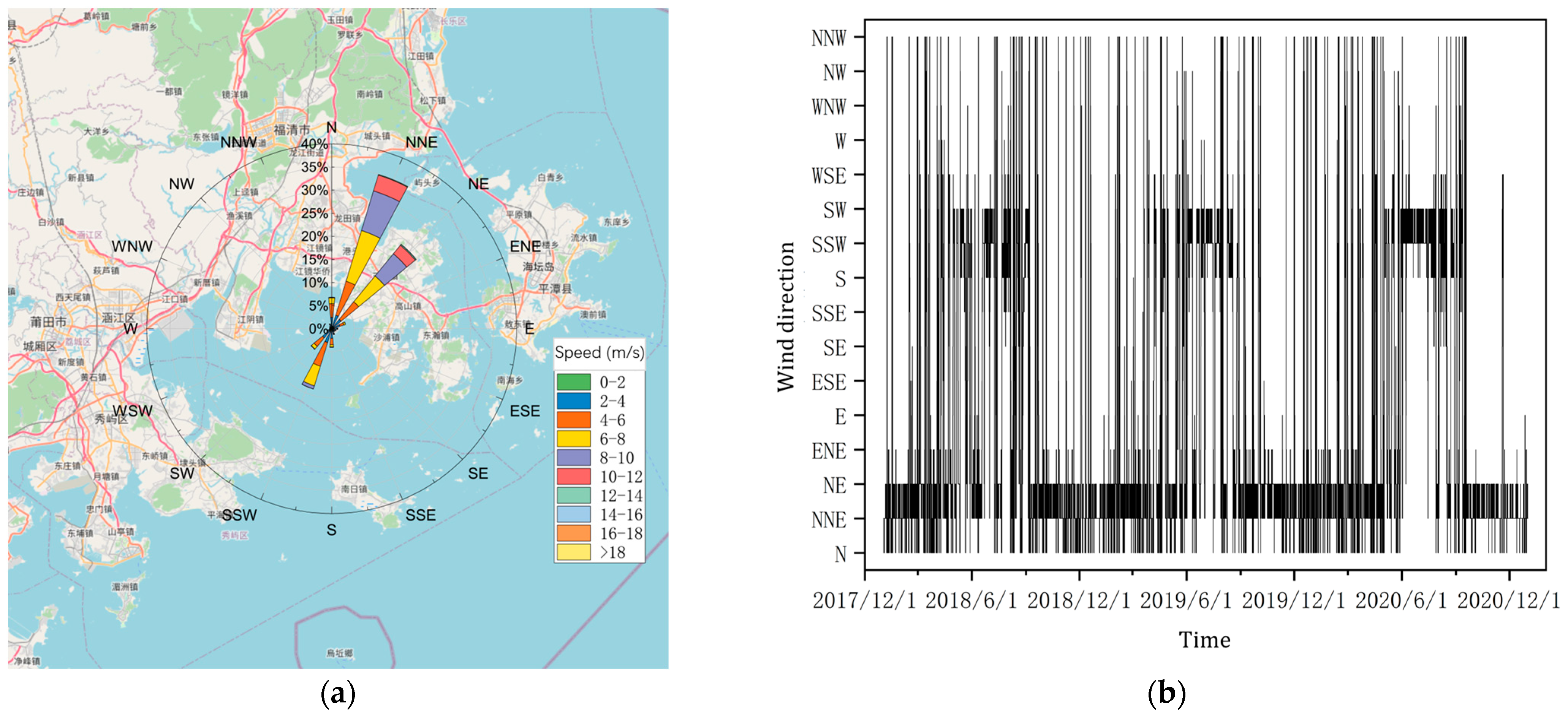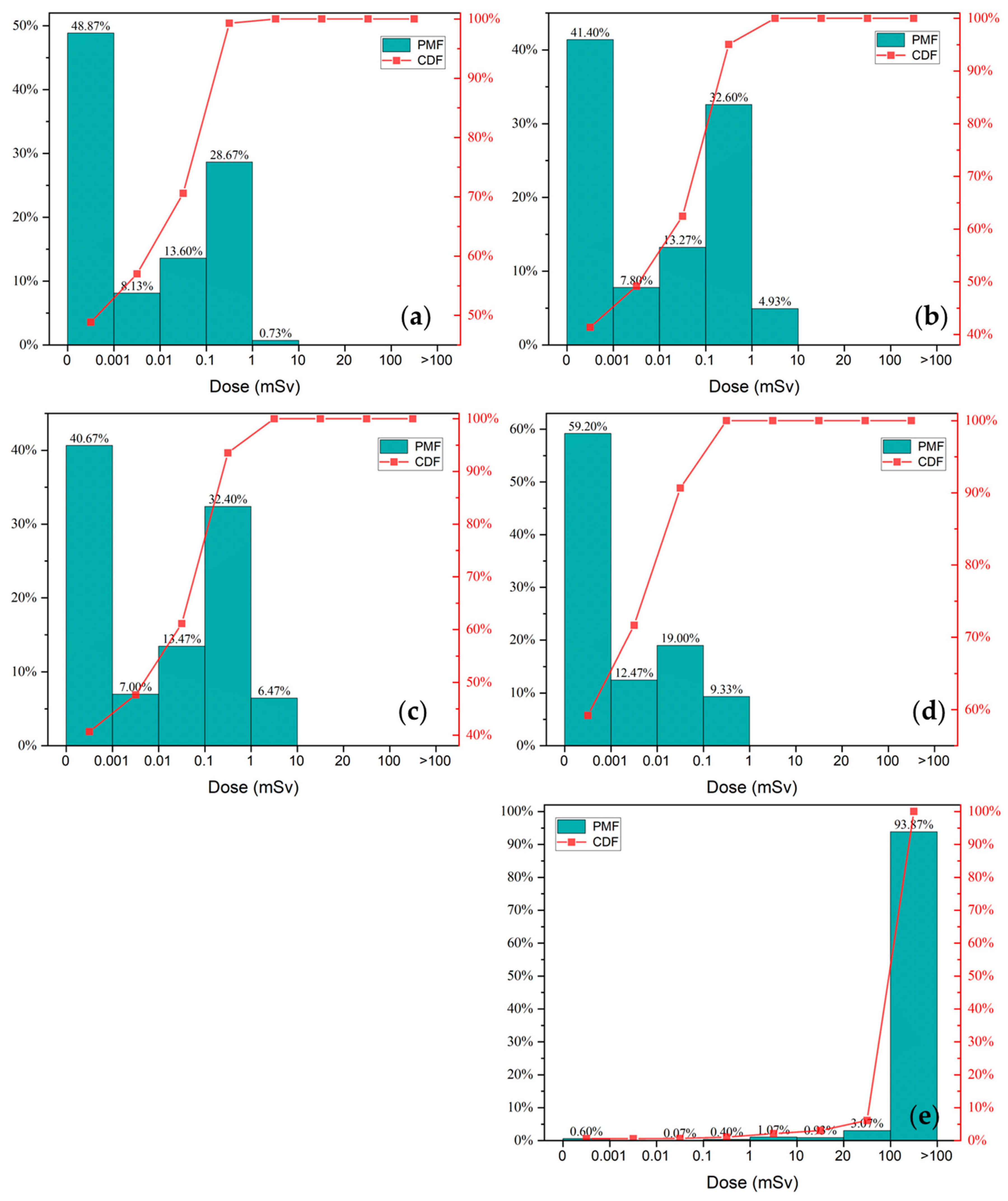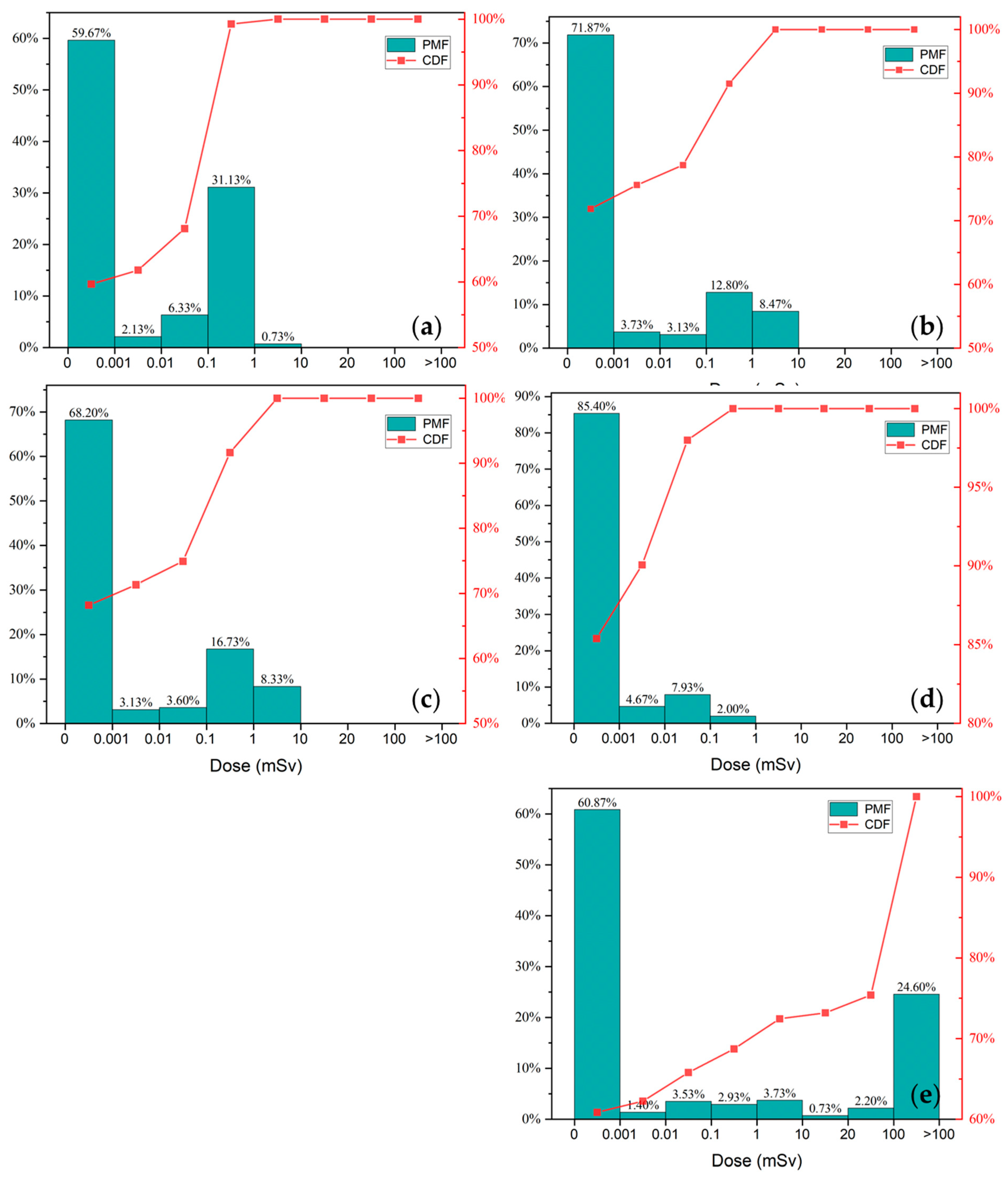Dynamic Dose-Based Emergency Evacuation Model for Enhancing Nuclear Power Plant Emergency Response Strategies
Abstract
1. Introduction
2. Dynamic Dose-Based Emergency Evacuation Model
2.1. Model Framework Structure
2.2. Map Module and Meteorological Data Module
2.3. Atmospheric Dispersion Module
2.4. Dose Calculation Module
- Cloudshine: radiation from the plume of radioactive aerosols;
- Groundshine: radiation from ground contamination;
- Acute inhalation: radioactive aerosol particles entering the body.
2.5. Evacuation Module
3. Optimal Evacuation Path Algorithm
- Step 1: Let be the weighted network flow graph, the origin node, all the destination nodes, and the evacuation path. Let .
- Step 2: For each destination node , let , where are all the neighboring nodes of . Let . It is obvious that . Let and .
- Step 3: If is one of the destination nodes, then output the evacuation path and end the algorithm. Otherwise, go to the step 2.
4. Simulation Input Data
4.1. Accident Source Term Data
4.2. Meteorological Data Analysis
4.3. Evacuee Parameters
5. Simulation and Analysis
5.1. Analysis of Typical Meteorological Conditions
- (1)
- Typical Meteorological Condition 1 (wind direction: S)
- (2)
- Typical Meteorological Condition 2 (wind direction: SSW)
- (3)
- Typical Meteorological Condition 3 (wind direction: SW)
5.2. Analysis of Random Meteorological Conditions
6. Conclusions
Author Contributions
Funding
Data Availability Statement
Conflicts of Interest
Abbreviations
| DDEEM | Dynamic dose-based emergency evacuation model |
| EPZ | Emergency planning zone |
| FGCCEM | Fuzzy gradient chance-constrained evacuation model |
| OREMS | Oak Ridge evacuation modeling system |
| CTA | Complex terrain based on the algorithm () |
| ECMWF | European Centre for Medium-Range Weather Forecasts () |
| DR | Dose risk |
| AF | Angle factor |
| DCF | Dose conversion factor |
References
- China Nuclear Society. China Nuclear Development Report; China Nuclear Society: Beijing, China, 2020. [Google Scholar]
- Li, F.; Wang, J.; Li, H.; Hu, Q.; Dan, W.; Ge, L.; Cohen, D. Evaluation on Nuclear Emergency Response Strategies in the Asia-Pacific Region. Int. J. Crit. Infra-Struct. Prot. 2021, 34, 100447. [Google Scholar] [CrossRef]
- GB/T 17680.1-2008; Guidelines for Nuclear Power Plant Emergency Plans and Preparedness—Part 1: Division of Emergency Planning Zones. China National Standardization Administration: Beijing, China, 2008.
- Sekiguchi, Y. An Ounce of Nuclear Prevention: A Window into Japanese Evacuation Planning for Nuclear Accidents. In CSIS Policy Perspective; CSIS: Washington, DC, USA, 2016; pp. 1–8. [Google Scholar]
- Urbanik, T. Evacuation Time Estimates for Nuclear Power Plants. J. Hazard. Mater. 2000, 75, 165–180. [Google Scholar] [CrossRef]
- Butler, D. Nuclear safety: Reactor, residents and risk. Nature 2011, 472, 274–275. [Google Scholar] [CrossRef][Green Version]
- Li, Z.; Hufang, G.H.; Guo, L.; Fan, Y.R.; Chen, J.P. A Fuzzy Gradient Chance-Constrained Evacuation Model for Managing Risks of Nuclear Power Plants under Multiple Uncertainties. J. Environ. Inform. 2015, 33, 129–138. [Google Scholar] [CrossRef]
- Hammond, G.D.; Bier, V.M. Alternative Evacuation Strategies for Nuclear Power Accidents. Reliab. Eng. Syst. Saf. 2015, 135, 9–14. [Google Scholar] [CrossRef]
- Zhou, H.; Zhang, H.; Chen, B.; Huo, J.; Lin, H. Optimum Vehicle Evacuation Plan for Nuclear Emergency Using Fuzzy Credibility Theory and Improved Genetic Algorithm. Arab. J. Sci. Eng. 2023, 48, 10517–10536. [Google Scholar] [CrossRef]
- Lee, J.; Jeong, J.J.; Shin, W.; Song, E.; Cho, C. The Estimated Evacuation Time for the Emergency Planning Zone of the Kori Nuclear Site, with a Focus on the Precautionary Action Zone. J. Radiat. Prot. Res. 2016, 41, 196–205. [Google Scholar] [CrossRef]
- Takabatake, T.; Shibayama, T.; Esteban, M.; Ishii, H.; Hamano, G. Simulated Tsunami Evacuation Behavior of Local Residents and Visitors in Kamakura, Japan. Int. J. Disaster Risk Reduct. 2017, 23, 1–14. [Google Scholar] [CrossRef]
- Sheffl, Y.; Mahmassani, H.; Powell, W.B. A Transportation Network Evacuation Model. Transp. Res. 1982, 16A, 209–218. [Google Scholar] [CrossRef]
- Moriarty, K.D.; Ni, D.; Collura, J. Modeling Traffic Flow under Emergency Evacuation Situations: Current Practice and Future Directions. In Proceedings of the 86th Transportation Research Board Annual Meeting, Washington, DC, USA, 21–25 January 2007; pp. 21–25. [Google Scholar]
- Cohen, R.; Weinisch, K. The Impact of a Major Earthquake on the Evacuation of the Emergency Planning Zone of a Nuclear Power Plant. J. Emerg. Manag. 2015, 13, 135–143. [Google Scholar] [CrossRef]
- Zhang, J.; Liu, Y.; Zhao, Y.; Deng, T. Emergency Evacuation Problem for a Multi-source and Multi-destination Transportation Network: Mathematical Model and Case Study. Ann. Oper. Res. 2020, 291, 1153–1181. [Google Scholar] [CrossRef]
- Rathand, A.K.; Solanki, R. Simulation of Traffic Flow During Emergency Evacuations: A Microcomputer Based Modeling System. In Proceedings of the 25th conference on Winter Simulation, Los Angeles, CA, USA, 12–15 December 1993; pp. 1250–1258. [Google Scholar]
- Chen, Y.; Shen, S.; Chen, T.; Yang, R. Path Optimization Study for Vehicles Evacuation Based on Dijkstra Algorithm. Procedia Eng. 2014, 71, 159–165. [Google Scholar] [CrossRef]
- Zou, Y.; Zou, S.; Niu, C. The Optimization of Emergency Evacuation from Nuclear Accidents in China. Sustainability 2018, 10, 2737. [Google Scholar] [CrossRef]
- Zhao, J.; Mao, M.; Xie, B. A Nuclear Emergency Partition Evacuation Framework Based on Comprehensive Risk Assessment. Int. J. Disaster Risk Reduct. 2023, 86, 103543. [Google Scholar] [CrossRef]
- Pei, Q.; Hao, L.; Chen, C.; Zheng, X.; He, T. Minimum Collective Dose Based Optimal Evacuation Path-planning Method under Nuclear Accidents. Ann. Nucl. Energy 2020, 147, 107644. [Google Scholar] [CrossRef]
- Hwang, Y.; Heo, G. Development of a Radiological Emergency Evacuation Model Using Agent-based Modeling. Nucl. Eng. Technol. 2021, 53, 2195–2206. [Google Scholar] [CrossRef]
- Tian, H.; Yang, Z.; Sun, G.; Wang, S.; Fu, J.; Tao, G. An Improved A* Path-planning Algorithm for Nuclear Spill Evacuation and Radioactive Source Retrieval in Complex Terrain. Nucl. Eng. Des. 2023, 408, 112314. [Google Scholar] [CrossRef]
- Choi, J.K.; Kim, J.W.; Joo, H.Y.; Moon, J.H. Applying a Big Data Analysis to Evaluate the Suitability of Shelter Locations for the Evacuation of Residents in Case of Radiological Emergencies. Nucl. Eng. Technol. 2023, 55, 261–269. [Google Scholar] [CrossRef]
- ERA5 Hourly Data on Single Levels from 1979 to Present. Available online: https://cds.climate.copernicus.eu/cdsapp#!/dataset/reanalysis-era5-single-levels?tab=overview (accessed on 1 April 2022).
- Scire, J.S.; Strimaitis, D.G.; Yamartino, R.J. A User’s Guide for the CALPUFF Dispersion Model. Earth Tech Inc. 2000, 521, 1–521. [Google Scholar]
- Dechter, R.; Pearl, J. Generalized Best-first Search Strategies and the Optimality of A. J. ACM 1985, 32, 505–536. [Google Scholar] [CrossRef]
- Hasegawa, R. Disaster Evacuation from Japan’s 2011 Tsunami Disaster and the Fukushima Nuclear Accident. Studies 2013, 1–54. [Google Scholar]
- Naghawi, H.; Wolshon, B. Transit-based Emergency Evacuation Simulation Modeling. J. Transp. Saf. Secur. 2010, 2, 184–201. [Google Scholar] [CrossRef]








| Parameter | Value |
|---|---|
| Horizontal initial dispersion coefficient () | |
| Vertical initial dispersion coefficient () | |
| Release height | |
| Release rate | |
| Deposition velocity | |
| Release rate | |
| Deposition velocity |
| N | North wind | S | South wind |
| NNE | North-northeast wind | SSW | South-southwest wind |
| NE | Northeast wind | SW | Southwest wind |
| ENE | East-northeast wind | WSW | West-southwest wind |
| E | East wind | W | West wind |
| ESE | East-southeast wind | WNW | West-northwest wind |
| SE | Southeast wind | NW | Northwest wind |
| SSE | South-southeast wind | NNW | North-northwest wind |
| Meteorological Condition | Wind Direction | Wind Direction (m/s) | Average Rainfall Intensity (mm/h) |
|---|---|---|---|
| Typical Meteorological Condition 1 | S | ||
| Typical Meteorological Condition 2 | SSW | ||
| Typical Meteorological Condition 3 | SW |
| Group | Destination | Speed | Departure Tim | Evacuation Path |
|---|---|---|---|---|
| Model calculation | Model calculation | |||
| In-place shelter |
| Nuclide | Radiation Path | Unit | Value |
|---|---|---|---|
| I-131 | Cloudshine | ||
| Groundshine | |||
| Inhalation | |||
| Cs-137 | Cloudshine | ||
| Groundshine | |||
| Inhalation |
Disclaimer/Publisher’s Note: The statements, opinions and data contained in all publications are solely those of the individual author(s) and contributor(s) and not of MDPI and/or the editor(s). MDPI and/or the editor(s) disclaim responsibility for any injury to people or property resulting from any ideas, methods, instructions or products referred to in the content. |
© 2023 by the authors. Licensee MDPI, Basel, Switzerland. This article is an open access article distributed under the terms and conditions of the Creative Commons Attribution (CC BY) license (https://creativecommons.org/licenses/by/4.0/).
Share and Cite
Miao, H.; Zhang, G.; Yu, P.; Shi, C.; Zheng, J. Dynamic Dose-Based Emergency Evacuation Model for Enhancing Nuclear Power Plant Emergency Response Strategies. Energies 2023, 16, 6338. https://doi.org/10.3390/en16176338
Miao H, Zhang G, Yu P, Shi C, Zheng J. Dynamic Dose-Based Emergency Evacuation Model for Enhancing Nuclear Power Plant Emergency Response Strategies. Energies. 2023; 16(17):6338. https://doi.org/10.3390/en16176338
Chicago/Turabian StyleMiao, Huifang, Guoming Zhang, Peizhao Yu, Chunsen Shi, and Jianxiang Zheng. 2023. "Dynamic Dose-Based Emergency Evacuation Model for Enhancing Nuclear Power Plant Emergency Response Strategies" Energies 16, no. 17: 6338. https://doi.org/10.3390/en16176338
APA StyleMiao, H., Zhang, G., Yu, P., Shi, C., & Zheng, J. (2023). Dynamic Dose-Based Emergency Evacuation Model for Enhancing Nuclear Power Plant Emergency Response Strategies. Energies, 16(17), 6338. https://doi.org/10.3390/en16176338





